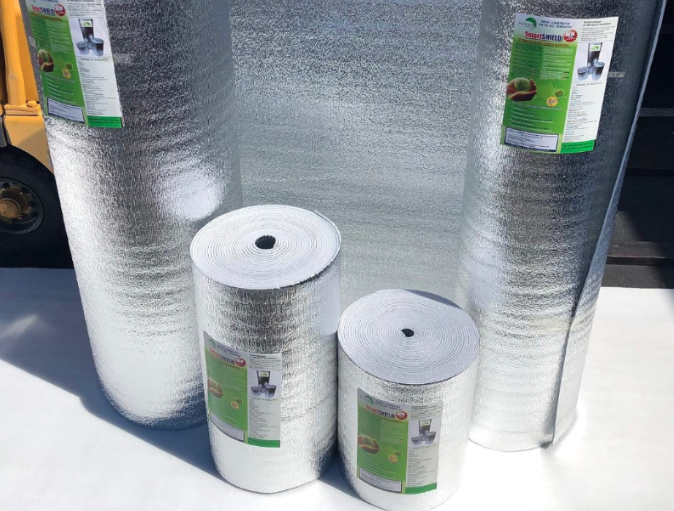What Is Reflective Insulation and Why It Changes the Game for Energy Efficiency
Let’s start with the question most people ask when they first hear the term: What is reflective insulation, and how is it different from all the other insulation types we already know?
It might look thin. It might seem simple. But reflective insulation is a smart solution designed to fight a very specific kind of heat. One that most traditional materials don’t handle well. If your garage feels like a sauna, your attic turns into an oven, or your metal building never cools down, reflective insulation might be exactly what you need.
It’s not just another version of fiberglass batts or foam panels. It’s something else entirely.
What Is Reflective Insulation?
Conventional insulation materials like fiberglass, cellulose, or foam resist heat by trapping air and slowing its transfer. They’re rated by R value, which measures how well they resist conductive heat flow. But R value tells you nothing about radiant heat.
Reflective insulation is made to deal with that third kind of heat transfer, radiation. It typically consists of one or more reflective foil surfaces bonded to a core material like foam or polyethylene bubbles. The shiny surface reflects up to 97 percent of radiant energy, especially when installed facing an open air space.
Think of it like a mirror for heat. Instead of absorbing that solar energy, it bounces it away from the structure. That keeps attics, garages, and metal buildings cooler without the need for thick, heavy insulation.
Where Reflective Insulation Makes a Big Difference
You’ll find reflective insulation doing its best work in attics, garages, metal barns, shipping containers, and pole buildings. Any structure that gets baked by the sun is a perfect candidate.
Why? Because in those environments, radiant heat makes up the majority of temperature increase. Think about a metal roof with no shade. The sunlight hits it directly, and that energy radiates into the structure. If there’s nothing to bounce it back, the heat just keeps on coming.
Reflective insulation placed under the roof deck or on the walls facing the sun can stop that heat from ever entering the space. It helps keep the building cooler, lowers the load on your air conditioner, and makes everything more comfortable.
Reflective Insulation Is Not Just for Hot Climates
It’s true that reflective insulation shines in hot weather. But that doesn’t mean it’s useless in winter. When used correctly, it can also reflect heat back into a space. For example, in a heated garage or workshop, reflective insulation installed on the walls can keep warmth from escaping outward. It helps trap that energy inside where you actually want it.
This makes it a year-round upgrade, not just a summertime fix.
Common Types and How They Fit
Reflective insulation comes in a few forms. One of the most popular is double bubble insulation, which uses two layers of polyethylene air bubbles between reflective foil sheets. The bubble layers provide structure and some resistance to conductive heat, while the foil reflects radiant energy.
This format is ideal for DIY installations because it’s flexible, lightweight, and moisture resistant. It’s easy to cut and does not require masks, gloves, or special tools. You’ll find it in everything from van conversions to pole barns to crawlspaces.
Then there’s the classic radiant barrier, a single sheet of reflective foil that works as a pure reflector without added insulation. Radiant barriers are most commonly installed in attics and large open spaces where maximizing reflectivity is the main goal.
Both options fall under the category of reflective insulation. The difference is that some types include extra material to resist conductive heat, while others focus entirely on radiant energy.
How Reflective Insulation Compares to Traditional Insulation
Reflective insulation is not a replacement for fiberglass or spray foam. It’s a supplement that tackles the heat those materials do not handle well.
In hot climates, relying on R value alone leaves you vulnerable to radiant heat gain, especially through the roof. Adding reflective insulation to your setup means you’re covering all bases, conduction, convection, and radiation.
It’s especially useful in retrofits. If you already have batt insulation in your attic, adding a radiant barrier to the rafters can immediately reduce heat load. If you’re insulating a garage, rolling out reflective insulation on the walls or door is a quick win with real performance benefits.
Getting the Right Fit for the Job
Before picking a product off the shelf, think about your space.
Is radiant heat your biggest issue? A radiant barrier could be your solution.
Do you need insulation and reflectivity in one? Go for reflective rolls or double bubble insulation.
Need to line a van or upgrade a grow room? Look for flexible, easy-to-trim rolls with a high reflectivity rating.
The goal is not to chase the highest R-value but to choose a product that targets the kind of heat that is actually causing the problem.
If you’re looking to improve energy performance and comfort in a way that’s fast, affordable, and easy to install, reflective insulation is worth serious consideration. For a full range of radiant barrier materials and reflective insulation rolls, visit Insulation MarketPlace and explore products built for real results, shipped directly to your door.
More Posts
Ultimate Comprehensive Guide to robert grant certificates nwbka
Comprehensive Guide to dooley funeral home antwerp ohio obituaries






